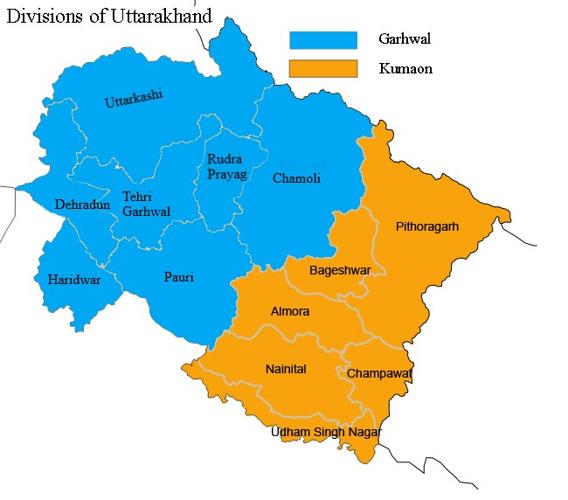Uttarakhand at Present
Uttarakhand, the 27th state of the Republic of India, came into existence on November 9th, 2000. Highlight its strategic location, bordered by Tibet to the north, Nepal to the east, and the Indian states of Himachal Pradesh and Uttar Pradesh to the west and south respectively.
It stands as one of the nation's fastest-growing states, boasting a robust economy with a per capita income of ₹ 198738 (FY 2018-19), surpassing the national average of ₹ 126406 (FY 2018-19). The state's economic backbone comprises three pivotal sectors: tourism, hydropower, and agriculture. Renowned for its breathtaking landscapes and cultural heritage, Uttarakhand attracts a significant influx of tourists each year. Moreover, its abundant water resources facilitate hydropower generation, contributing substantially to the state's energy needs. Agriculture also plays a vital role in sustaining livelihoods and fostering rural development. With a commendable literacy rate of 79.63%, Uttarakhand underscores its commitment to education and human capital development.
Geographical Features
Describe Uttarakhand's diverse geographical features, including the majestic Himalayan mountain ranges, lush forests, sacred rivers like the Ganges and Yamuna, and picturesque hill stations.
Emphasize its significance as a major pilgrimage destination with revered sites such as Badrinath, Kedarnath, Gangotri, and Yamunotri.
Discuss its importance as a biodiversity hotspot, hosting a wide variety of flora and fauna.
Cultural Heritage
Explore Uttarakhand's rich cultural heritage, shaped by centuries of Hindu traditions and beliefs.
Highlight its vibrant festivals, folk music, dance forms like Garhwali and Kumaoni, and traditional arts and crafts.
Discuss the influence of various dynasties and rulers, such as the Katyuri dynasty, on the region's architecture, particularly evident in the numerous temples and forts dotting the landscape.
Economic Development
Examine Uttarakhand's economy, which relies primarily on agriculture, horticulture, tourism, and hydroelectric power generation.
Discuss the state government's initiatives to promote sustainable development, eco-tourism, and infrastructure projects to boost economic growth.
Highlight challenges such as environmental conservation, seasonal migration, and unemployment, and explore potential solutions.
Future Prospects
Conclude by discussing the potential for Uttarakhand's future development, including harnessing renewable energy sources, promoting organic farming, and enhancing connectivity through improved transportation infrastructure.
Emphasize the importance of preserving its natural and cultural heritage while fostering inclusive and sustainable growth for all its residents.
Kumaon & Garhwal Divisions of Uttarakhand

Uttarakhand has made progress in various aspects since its inception. Here are some notable areas of development and progress in present-day Uttarakhand:
1. Infrastructure: Uttarakhand has witnessed significant improvements in infrastructure development, including the expansion of road networks, construction of bridges, and better connectivity to remote areas. Efforts have been made to enhance transportation facilities, promote tourism, and facilitate economic growth.
2. Tourism: Uttarakhand is known for its natural beauty, pilgrimage sites, and adventure tourism. The state has seen a boost in tourism, with efforts to develop and promote tourist destinations such as Dehradun, Mussoorie, Nainital, Haridwar, Rishikesh, and the hill stations of Kumaon and Garhwal regions. Tourism infrastructure, accommodations, and facilities have been developed to cater to the increasing number of tourists.
3. Education: Uttarakhand has made progress in the education sector, with the establishment of universities, colleges, and educational institutions. Efforts have been made to improve the quality of education and provide better access to educational opportunities, especially in remote areas.
4. Health and Healthcare: The state has focused on improving healthcare facilities and services. More hospitals, clinics, and healthcare centers have been established to provide better medical care to the population. Initiatives have been undertaken to strengthen healthcare infrastructure and enhance the delivery of healthcare services.
5. Environmental Conservation: Uttarakhand is known for its rich biodiversity and ecological significance. The state has taken steps to preserve and protect its natural resources through measures like afforestation, wildlife conservation, and promoting sustainable practices. Various programs and initiatives have been implemented to create awareness about environmental conservation and sustainable development.
6. Agriculture and Horticulture: Uttarakhand has a predominantly agrarian economy. Efforts have been made to boost agricultural productivity, promote organic farming practices, and support horticulture, especially in the production of fruits like apples, strawberries, and peaches. The state government has introduced schemes and programs to provide assistance and subsidies to farmers.
7. Economy: Uttarakhand's economy has diversified over the years, with growth in various sectors like agriculture, horticulture, tourism, and manufacturing industries. The state has also promoted eco-tourism and sustainable practices to preserve its natural resources.
8. Power Generation: The state has significant potential for hydroelectric power generation. It has harnessed its water resources for electricity production, contributing to its economic development.
9. Employment Opportunities: With growing industries and increased focus on tourism and hospitality, Uttarakhand has provided more employment opportunities for its residents.
10. Disaster Preparedness: Uttarakhand has experienced natural disasters like landslides and floods in the past. Efforts have been made to improve disaster preparedness and response to mitigate the impact of such calamities.
